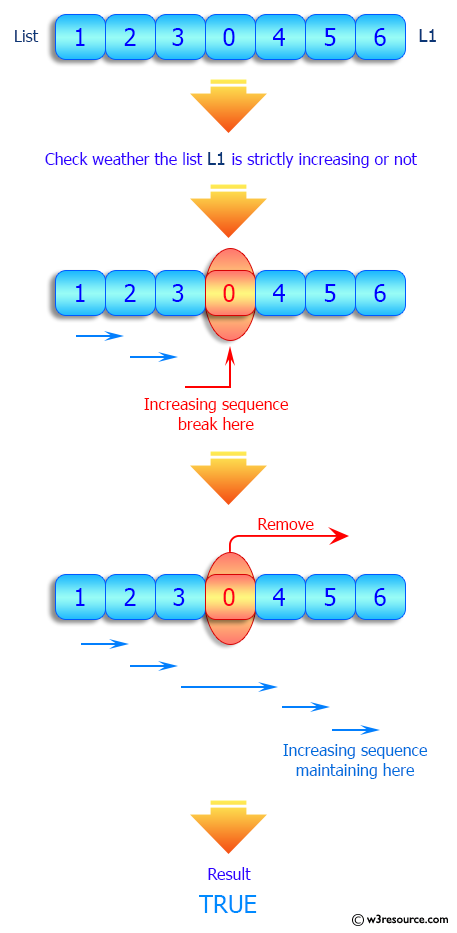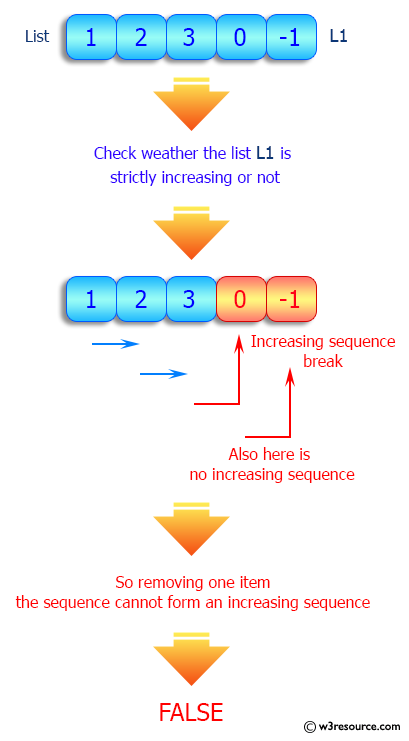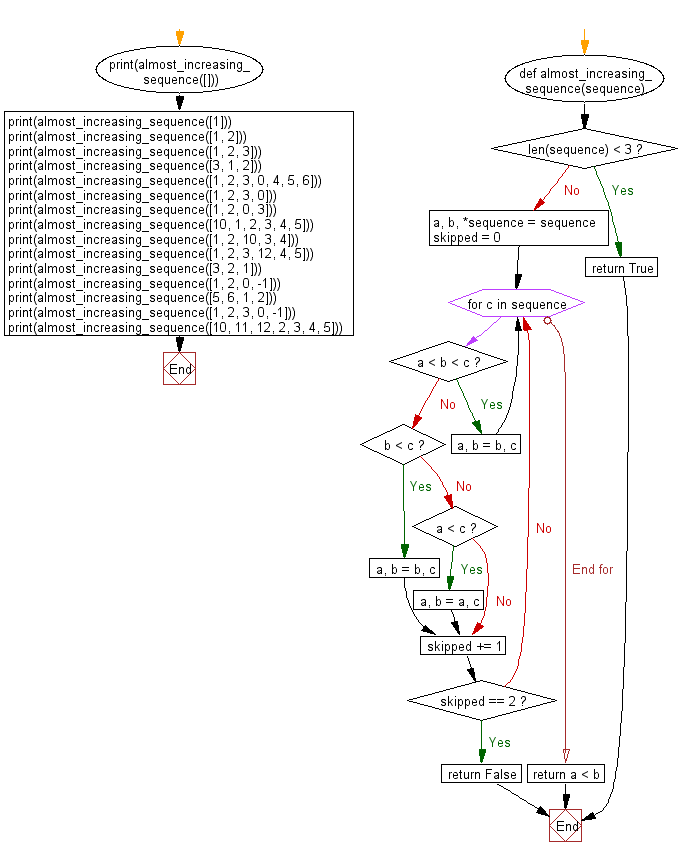Python: Check if a given list is strictly increasing or not
Python List: Exercise - 161 with Solution
Write a Python program to check if a given list is strictly increasing or not. Moreover, If removing only one element from the list results in a strictly increasing list, we still consider the list true.
Sample Solution:
Python Code:
# Source: https://bit.ly/3qZqcwm
def almost_increasing_sequence(sequence):
if len(sequence) < 3:
return True
a, b, *sequence = sequence
skipped = 0
for c in sequence:
if a < b < c: # XXX
a, b = b, c
continue
elif b < c: # !XX
a, b = b, c
elif a < c: # X!X
a, b = a, c
skipped += 1
if skipped == 2:
return False
return a < b
print(almost_increasing_sequence([]))
print(almost_increasing_sequence([1]))
print(almost_increasing_sequence([1, 2]))
print(almost_increasing_sequence([1, 2, 3]))
print(almost_increasing_sequence([3, 1, 2]))
print(almost_increasing_sequence([1, 2, 3, 0, 4, 5, 6]))
print(almost_increasing_sequence([1, 2, 3, 0]))
print(almost_increasing_sequence([1, 2, 0, 3]))
print(almost_increasing_sequence([10, 1, 2, 3, 4, 5]))
print(almost_increasing_sequence([1, 2, 10, 3, 4]))
print(almost_increasing_sequence([1, 2, 3, 12, 4, 5]))
print(almost_increasing_sequence([3, 2, 1]))
print(almost_increasing_sequence([1, 2, 0, -1]))
print(almost_increasing_sequence([5, 6, 1, 2]))
print(almost_increasing_sequence([1, 2, 3, 0, -1]))
print(almost_increasing_sequence([10, 11, 12, 2, 3, 4, 5]))
Sample Output:
True True True True True True True True True True True False False False False False
Pictorial Presentation:



Flowchart:

Visualize Python code execution:
The following tool visualize what the computer is doing step-by-step as it executes the said program:
Python Code Editor:
Have another way to solve this solution? Contribute your code (and comments) through Disqus.
Previous: Write a Python program to remove first specified number of elements from a given list satisfying a condition.
Next: Write a Python program to find the last occurrence of a specified item in a given list.
What is the difficulty level of this exercise?
Test your Programming skills with w3resource's quiz.
Python: Tips of the Day
Find current directory and file's directory:
To get the full path to the directory a Python file is contained in, write this in that file:
import os dir_path = os.path.dirname(os.path.realpath(__file__))
(Note that the incantation above won't work if you've already used os.chdir() to change your current working directory, since the value of the __file__ constant is relative to the current working directory and is not changed by an os.chdir() call.)
To get the current working directory use
import os cwd = os.getcwd()
Documentation references for the modules, constants and functions used above:
- The os and os.path modules.
- The __file__ constant
- os.path.realpath(path) (returns "the canonical path of the specified filename, eliminating any symbolic links encountered in the path")
- os.path.dirname(path) (returns "the directory name of pathname path")
- os.getcwd() (returns "a string representing the current working directory")
- os.chdir(path) ("change the current working directory to path")
Ref: https://bit.ly/3fy0R6m
- New Content published on w3resource:
- HTML-CSS Practical: Exercises, Practice, Solution
- Java Regular Expression: Exercises, Practice, Solution
- Scala Programming Exercises, Practice, Solution
- Python Itertools exercises
- Python Numpy exercises
- Python GeoPy Package exercises
- Python Pandas exercises
- Python nltk exercises
- Python BeautifulSoup exercises
- Form Template
- Composer - PHP Package Manager
- PHPUnit - PHP Testing
- Laravel - PHP Framework
- Angular - JavaScript Framework
- Vue - JavaScript Framework
- Jest - JavaScript Testing Framework
